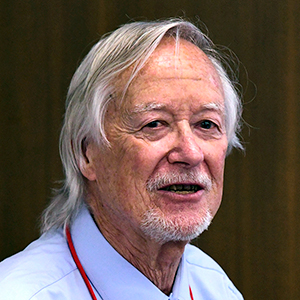Oregon State University (OSU) scientists funded in part by NIEHS have discovered a new class of anti-cancer compounds that effectively kill liver and breast cancer cells.
The findings, published online April 24 in the journal Apoptosis, describe the discovery and characterization of those compounds, called Select Modulators of AhR-regulated Transcription (SMAhRTs).
Potential therapeutics
Edmond O’Donnell III, M.D., Ph.D., from the University of California, Davis Medical Center, and a team of OSU scientists conducted the research in the laboratory of Siva Kolluri, Ph.D., from the university’s department of environmental and molecular toxicology. They also identified the aryl hydrocarbon receptor (AhR) as a new molecular target for development of cancer therapeutics.
 Kolluri, left, posed with his OSU colleague and study co-author Nancy Kerkvliet, Ph.D. (Photo courtesy of OSU)
Kolluri, left, posed with his OSU colleague and study co-author Nancy Kerkvliet, Ph.D. (Photo courtesy of OSU)“Our research identified a therapeutic lead that acts through a new molecular target for treatment of certain cancers,” Kolluri said.
“This is an exciting development, which lays a foundation for a new class of anti-cancer therapeutics acting through the AhR,” O’Donnell III added.
Killing liver, breast cancer cells
Two molecular screening techniques the researchers used helped them discover potential SMAhRTs and identify a molecule — known as CGS-15943 — that activates AhR signaling and kills liver and breast cancer cells.
 O’Donnell III is currently a second-year resident in orthopedic surgery at the University of California, Davis Medical Center. (Photo courtesy of Edmond O’Donnell III)
O’Donnell III is currently a second-year resident in orthopedic surgery at the University of California, Davis Medical Center. (Photo courtesy of Edmond O’Donnell III)Specifically, the scientists studied cells from human hepatocellular carcinoma, a common type of liver cancer, and cells from triple negative breast cancer that account for about 15% of breast cancers with the worst prognosis.
Encouraging results
“We focused on these two types of cancer because they are difficult to treat and have limited treatment options,” said Kolluri. “We were encouraged by the results because they are unrelated cancers and targeting the AhR was effective in inducing death of both of these distinct cancers.”
The researchers also identified AhR-mediated pathways that contribute to the anti-cancer actions of CGS-15943. Developing cancer treatments requires a detailed understanding of such actions. The team determined that CGS-15943 increases the expression of a protein called Fas Ligand through the AhR and causes cancer cell death.
These results provide exciting new leads for drug development, but human therapies based on these results may not be available to patients for 10 years, according to the researchers.
 The images on the right show human hepatocellular carcinoma cells with the expression of the target AhR being killed upon treatment with the identified lead compound. The images on the left are human hepatocellular carcinoma cells without the target AhR. (Photo courtesy of OSU)
The images on the right show human hepatocellular carcinoma cells with the expression of the target AhR being killed upon treatment with the identified lead compound. The images on the left are human hepatocellular carcinoma cells without the target AhR. (Photo courtesy of OSU)Other funding for this research was provided by the American Cancer Society, the U.S. Army Medical Research and Material Command, the Department of Defense Breast Cancer Research Program, the National Cancer Institute, and Oregon State University.
An editorial commemorating the 25th anniversary issue of the journal Apoptosis highlighted the team’s discovery and the detailed investigation of cancer cell death promoted by CGS-15943.
Citation: O'Donnell EF 3rd, Jang HS, Liefwalker DF, Kerkvliet NI, Kolluri SK. 2021. Discovery and mechanistic characterization of a select modulator of AhR-regulated transcription (SMAhRT) with anti-cancer effects. Apoptosis. doi: 10.1007/s10495-021-01666-0.
(This story is based on a press release by Sean Nealon of OSU.)









